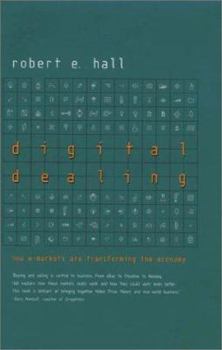Digital Dealing: How E-Markets Are Transforming the Economy
Discusses auction deal engines at both the consumer and the business-to-business level, stock and bond auctions, procurement auctions, real-time deal engines, posted-price deal engines, antitrust... This description may be from another edition of this product.
Format:Hardcover
Language:English
ISBN:0393042103
ISBN13:9780393042108
Release Date:January 2002
Publisher:W. W. Norton & Company
Length:239 Pages
Weight:1.15 lbs.
Dimensions:0.9" x 6.3" x 9.5"
Customer Reviews
1 rating
A prelude to online, automated, intelligent eCommerce.
Published by Thriftbooks.com User , 20 years ago
In spite of predictions of doom by some, eCommerce is here to stay, and in fact will evolve into something that might be called "eDealing" or "eNegotiation". Whatever it is called, the ability to negotiate deals real-time on the Web is something that is coming fast, and will be driven by the need for transparency and efficiency in this kind of deal-making. The author has given an interesting but elementary account of what he has named "digital dealing", which could be read by anyone who is interested in this type of technology. All of the current financial institutions will eventually have to face up to the presence of e-markets in the months and years ahead. Due to space constraints, only the first four chapters will be reviewed here. In chapter 1 of the book the author gives an overview of the nature of e-markets, and the phenomenon of "dickering" (bargaining or haggling) for the best price. Successful e-markets in his view must support automated versions of dickering, and engage in deal-making despite the desire to hide the 'best price'. The author gives four steps that he believes will ensure a successful e-commerce system: the identification of potential trading partners, followed by the transmission and reception of trading interest and dickering with potential partners, the actual carrying out the deal, and lastly the providing of the information about the deal to other traders. He also lists, and then discusses what he believes are the most effective e-market models: eBay, OffRoad, FreeMarkets, Nasdaq, Priceline, and Grainger. The author also discusses the need for transparency in terms of three categories, namely the identity of traders, the terms of the bids, and the terms of the deal. The author does not overemphasize the role of e-markets, and clearly many firms still using traditional business practices are feeling threatened by them. No doubt they will have to adapt to the organized, efficient, and rational nature of e-markets. Chapter 2 overviews the "deal engines" that can do auctions, with the first example the author studying being the English auction, which is deployed by sites such as eBay, and which the author claims is the predominant form of auctioneering on the Internet. What is interesting about the eBay auction process, as pointed out by the author, is that it uses "proxy bidding", which does not require a bidder to be logged on in the bidding process. This automation of the bidding process will be even more powerful when it is extended to more elaborate financial transactions. The author also discusses the trade-offs involved in transparency during the bidding process. First-price and second-price sealed-bid auctions are also discussed, and the author compares these three different types of auctions according to their advantages for bidder and seller. The author also explains the use of the activity rule in making auctions more transparent. Even more importantly, the author discusses two-sided auctions, which are used





